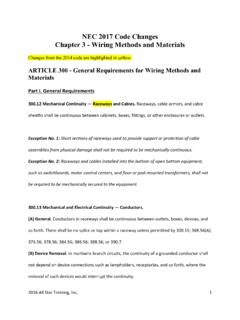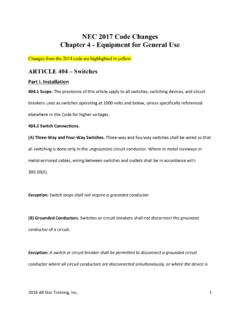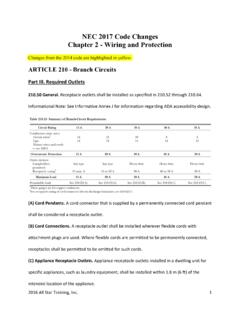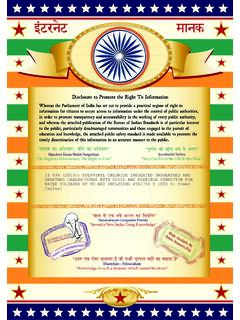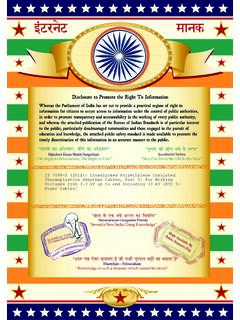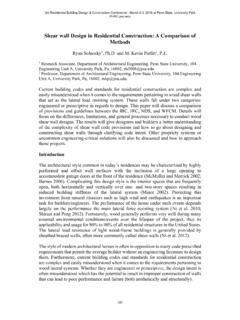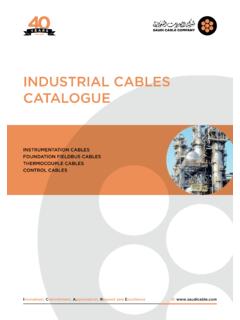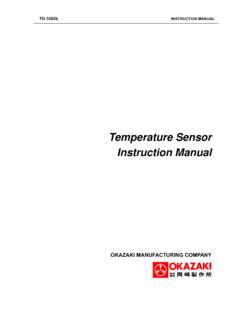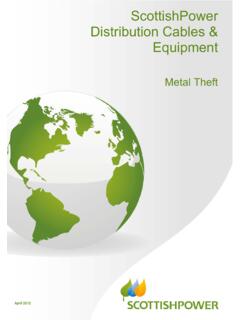Transcription of NEC 2017 Code Changes Chapter 3 - Wiring Methods and …
1 2016 All Star Training, Inc. 1 NEC 2017 Code Changes Chapter 3 - Wiring Methods and Materials Changes from the 2014 code are highlighted in yellow. ARTICLE 300 - General Requirements for Wiring Methods and Materials Part I. General Requirements Scope. (A) All Wiring Installations. This article covers general requirements for Wiring Methods and materials for all Wiring installations unless modified by other articles in Chapter 3. (B) Integral Parts of Equipment. The provisions of this article are not intended to apply to the conductors that form an integral part of equipment, such as motors, controllers, motor control centers, or factory-assembled control equipment or listed utilization equipment.
2 (C) Metric Designators and Trade Sizes. Metric designators and trade sizes for conduit, tubing, and associated fittings and accessories shall be as designated in Table (C). 2016 All Star Training, Inc. 2 Limitations. (A) Voltage. Wiring Methods specified in Chapter 3 shall be used for 1000 volts, nominal, or less where not specifically limited in some section of Chapter 3. They shall be permitted for over 1000 volts, nominal, where specifically permitted elsewhere in this Code. (B) Temperature. Temperature limitation of conductors shall be in accordance with (A)(3). Conductors. (A) Single Conductors.
3 Single conductors specified in Table (A) shall only be installed where part of a recognized Wiring method of Chapter 3. Exception: Individual conductors shall be permitted where installed as separate overhead conductors in accordance with (B) Conductors of the Same Circuit. All conductors of the same circuit and, where used, the grounded conductor and all equipment grounding conductors and bonding conductors shall be contained within the same raceway, auxiliary gutter, cable tray, cablebus assembly, trench, cable, or cord, unless otherwise permitted in accordance with (B)(1) through (B)(4).
4 (1) Paralleled Installations. Conductors shall be permitted to be run in parallel in accordance with the provisions of (H). The requirement to run all circuit conductors within the same raceway, auxiliary gutter, cable tray, trench, cable, or cord shall apply separately to each portion of the paralleled installation, and the equipment 2016 All Star Training, Inc. 3 grounding conductors shall comply with the provisions of Parallel runs in cable tray shall comply with the provisions of (C). Exception: Conductors installed in nonmetallic raceways run underground shall be permitted to be arranged as isolated phase, neutral, and grounded conductor installations.
5 The raceways shall be installed in close proximity, and the isolated phase, neutral, and grounded conductors shall comply with the provisions of (B). (2) Grounding and Bonding Conductors. Equipment grounding conductors shall be permitted to be installed outside a raceway or cable assembly where in accordance with the provisions of (C) for certain existing installations or in accordance with (B), Exception No. 2, for dc circuits. Equipment bonding conductors shall be permitted to be installed on the outside of raceways in accordance with (E). (3) Nonferrous Wiring Methods . Conductors in Wiring Methods with a nonmetallic or other nonmagnetic sheath, where run in different raceways, auxiliary gutters, cable trays, trenches, cables, or cords, shall comply with the provisions of (B).
6 Conductors in single-conductor Type MI cable with a nonmagnetic sheath shall comply with the provisions of Conductors of single-conductor Type MC cable with a nonmagnetic sheath shall comply with the provisions of , , and (B). (4) Column-Width Panelboard Enclosures. Where an auxiliary gutter runs between a column-width panelboard and a pull box, and the pull box includes neutral terminations, the neutral conductors of circuits supplied from the panelboard shall be permitted to originate in the pull box. 2016 All Star Training, Inc. 4 (C) Conductors of Different Systems. (1) 1000 Volts, Nominal, or Less.
7 Conductors of ac and dc circuits, rated 1000 volts, nominal, or less, shall be permitted to occupy the same equipment Wiring enclosure, cable, or raceway. All conductors shall have an insulation rating equal to at least the maximum circuit voltage applied to any conductor within the enclosure, cable, or raceway. Secondary Wiring to electric-discharge lamps of 1000 volts or less, if insulated for the secondary voltage involved, shall be permitted to occupy the same luminaire, sign, or outline lighting enclosure as the branch-circuit conductors. Informational Note No. 1: See (A) for Class 2 and Class 3 circuit conductors.
8 Informational Note No. 2: See (B) for photovoltaic source and output circuits. (2) Over 1000 Volts, Nominal. Conductors of circuits rated over 1000 volts, nominal, shall not occupy the same equipment Wiring enclosure, cable, or raceway with conductors of circuits rated 1000 volts, nominal, or less unless otherwise permitted in (C)(2)(a) through (C)(2)(d). (a) Primary leads of electric-discharge lamp ballasts insulated for the primary voltage of the ballast, where contained within the individual Wiring enclosure, shall be permitted to occupy the same luminaire, sign, or outline lighting enclosure as the branch-circuit conductors.
9 (b) Excitation, control, relay, and ammeter conductors used in connection with any individual motor or starter shall be permitted to occupy the same enclosure as the motor-circuit conductors. 2016 All Star Training, Inc. 5 (c) In motors, transformers, switchgear, switchboards, control assemblies, and similar equipment, conductors of different voltage ratings shall be permitted. (d) In manholes, if the conductors of each system are permanently and effectively separated from the conductors of the other systems and securely fastened to racks, insulators, or other approved supports, conductors of different voltage ratings shall be permitted.
10 Conductors having nonshielded insulation and operating at different voltage levels shall not occupy the same enclosure, cable, or raceway. Protection Against Physical Damage. Where subject to physical damage, conductors, raceways, and cables shall be protected. Informational Note: Minor damage to a raceway, cable armor, or cable insulation does not necessarily violate the integrity of either the contained conductors or the conductors insulation. (A) Cables and Raceways Through Wood Members. (1) Bored Holes. In both exposed and concealed locations, where a cable- or raceway-type Wiring method is installed through bored holes in joists, rafters, or wood members, holes shall be bored so that the edge of the hole is not less than 32 mm (11 4 in.)
